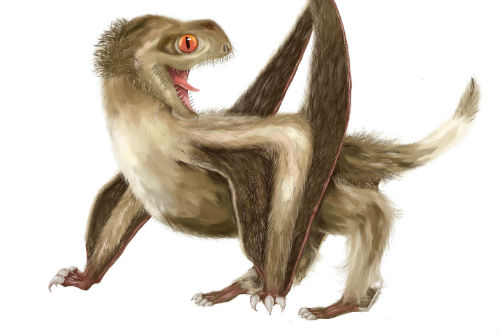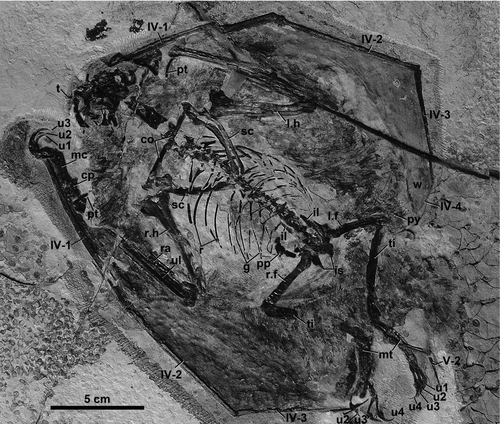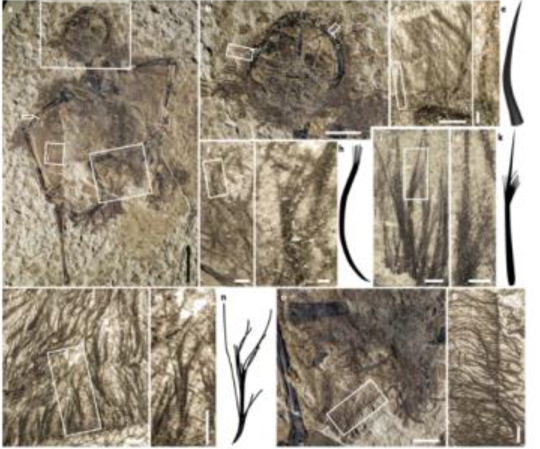Are the Feathers About to Fly in the Pterosauria?
Study Finds Four Types of Feather-like Structures in Pterosaur Fossils
Most palaeontologists have accepted that it is likely that pterosaurs (flying reptiles), were covered in a sort of hairy fuzz, technically referred to as pycnofibres, that helped insulate their bodies and keep them warm. However, an international team of scientists from Hong Kong University, Nanjing University (China), University College Cork, University College Dublin (Ireland), the Foundation for Scientific Advancement, (Arizona, USA), the Chinese Academy of Sciences and Bristol University (UK) have published a scientific paper that describes four kinds of feather-like structures associated with the fossilised remains pterosaurs.
If these structures are feathers, then this suggests that either the Pterosauria evolved feathers as a form of convergent evolution, or, that feathers evolved many millions of years earlier than previously thought – in a common ancestor of the Dinosauria and the Pterosauria.
A Life Reconstruction of the Chinese Anurognathid Pterosaur

Picture credit: Yuan Zhang
Two Anurognathid Pterosaur Specimens Studied
Writing in the academic journal “Nature Ecology and Evolution”, the scientists report how high-resolution microscopy revealed evidence of different kinds of pycnofibres on two pterosaur fossils (representing anurognathids), from the Daohugou Formation in Inner Mongolia. Although, when the rocks that make up the Daohugou Formation were deposited has been debated and the relative dating of these sediments in relation to other Chinese Jurassic/Early Cretaceous formations has proved controversial, it is suggested that the pterosaurs, one of which represents a new species, lived approximately 160 million years ago.
Four feather-like structures were identified:
- simple filaments (hairs)
- bundles of filaments
- filaments with a tuft halfway down the shaft
- down feathers
The Scientists Identified Four Types of Feather-like Structures in the Fossils
Picture credit: Yang, Jiang, McNamara et al
An Amazing Pterosaur Discovery
One of the paper’s authors, Dr Maria McNamara (University College Cork), stated that some critics have suggested that there is only one simple hair-like type of pycnofibre, but this study shows different structures that we also see in dinosaurs, in essence real feathers. Furthermore, the team identified melanosomes that indicate that some flying reptiles may have been coloured a sort of reddish brown.
Dr McNamara explained:
“We focused on areas where the feathers did not overlap and where we could see their structure more clearly. They even show fine details of pigment granules, which may have given the fluffy feathers a ginger colour. This discovery has amazing implications for our understanding of the origin of feathers, but also for a major time of revolution of life on land. When feathers arose, about 250 million years ago, life was recovering from the devastating end-Permian mass extinction.”
The Enigmatic Anurognathidae
Only a handful of anurognathid fossils are known and only a few species have been assigned to this pterosaur family. Although, the first anurognathids were described from Upper Jurassic deposits of Bavaria (Solnhofen limestone), the best preserved and most complete specimens came from the Daohugou Beds of Inner Mongolia. Since these types of small, short-faced flying reptiles are known from Europe, South Korea, China and potentially North America, they seem to have been geographically widespread. Although very rare, the Daohugou Bed fossil specimens have some soft tissue and muscle outline preservation and have provided palaeontologists with a lot of information on pterosaur anatomy.
An Anurognathid Pterosaur from the Daohugou Beds – Jeholopterus ninchengensis

Picture credit: Chinese Academy of Sciences/Journal of Vertebrate Palaeontology
Re-writing the History of the Evolution of Feathers
Feathers are essentially highly modified scales; this new research could potentially re-write the evolutionary history of feathers. One of the authors, Professor Mike Benton (Bristol University), explained:
“We ran some evolutionary analyses and they showed clearly that the pterosaur pycnofibres are feathers, just like those seen in modern birds and across various dinosaur groups. Despite careful searching, we couldn’t find any anatomical evidence that the four pycnofibre types are in any way different from the feathers of birds and dinosaurs. Therefore, because they are the same, they must share an evolutionary origin, and that was about 250 million years ago, long before the origin of birds.”
Birds have two types of advanced feathers used in flight and for body smoothing, the contour feathers with a hollow quill and barbs down both sides. These types of feathers are found only in birds and the theropod dinosaurs close to the evolutionary origins of the Aves (birds). However, the other feather types of modern birds include monofilaments and down feathers, and these are seen much more widely across dinosaurs and pterosaurs.
Growth Suppressed
The armoured dinosaurs and the giant sauropods probably did not have feathers, but they were likely suppressed, meaning they were prevented from growing, at least in the adults, just as hair is suppressed in large-bodied animals today such as cetaceans, hippos and elephants.
High Resolution Microscopy Revealed Different Types of Feather-like Structures
Picture credit: Yang, Jiang, McNamara et al
Professor Benton added:
“This discovery has amazing implications for our understanding of the origin of feathers, but also for a major time of revolution of life on land. When feathers arose, about 250 million years ago, life was recovering from the devasting end-Permian mass extinction. Independent evidence shows that land vertebrates, including the ancestors of mammals and dinosaurs, had switched gait from sprawling to upright, had acquired different degrees of warm-bloodedness, and were generally living life at a faster pace.”
He went on:
“The mammal ancestors by then had hair, so likely the pterosaurs, dinosaurs and relatives had also acquired feathers to help insulate them. The hunt for feathers in fossils is heating up and finding their functions in such early forms is imperative. It can rewrite our understanding of a major revolution in life on Earth during the Triassic, and also our understanding of the genomic regulation of feathers, scales, and hairs in the skin.”
Different Kinds of Pycnofibres – Different Functions?
Pterosaurs were the first back-boned animals to evolve powered flight. However, following their extinction at the end of the Cretaceous, they left no living close relatives, nor indeed any near related analogues for scientists to study. Whilst the presence of pycnofibres on the bodies of these flying reptiles is quite well accepted by the scientific community, their functions are not fully understood. If different types of feather-like structures have been identified in two anurognathid pterosaur specimens, it is likely that other types of pterosaur had them too.
These different feather-like structures probably served a variety of functions, perhaps the first “pterosaur fuzz” evolved to provide insulation and then other types evolved perhaps to aid tactile sensing, visual communication and to assist with flight.
The scientific paper: “Pterosaur Integumentary Structures with Complex Feather-like Branching” by Z. Yang, B. Jiang, M. McNamara, S. Kearns, M. Pittman, T. Kaye, P. Orr, X. Xu and M. Benton and published in Nature Ecology and Evolution.
Everything Dinosaur acknowledges the assistance of a press release from Bristol University in the compilation of this article.
Visit the Everything Dinosaur website: Everything Dinosaur.



